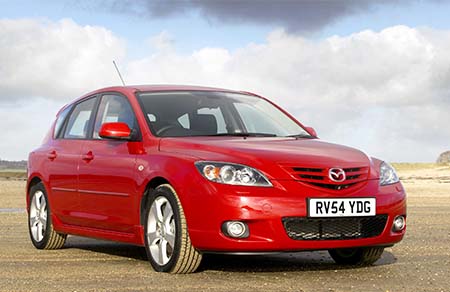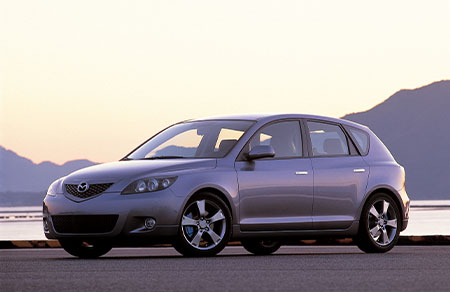The Mazda3 has achieved a significant milestone by being on the market for two decades. It made its debut at the 2003 Frankfurt Motor Show, with the first-generation Mazda3 arriving at European dealerships in the autumn of 2003.
This model was built upon the success of the Mazda 323, which had served as Mazda’s flagship family hatchback in the European market for four generations. It was also a major sales success in Japan, where it was known as the Familia, and worldwide.

Mazda3 Monumental Moment
A pivotal moment that hinted at the future of the Mazda3 occurred at the 2003 Geneva Motor Show, where Mazda showcased the MX Sportif concept car. This concept boldly displayed the design direction for Mazda’s upcoming family hatchback. The design was led by chief designer Hideki Suzuki and involved collaboration among Mazda’s design centres in California, Germany, and Japan.
When the final production version, designed by Hasip Girgin, was unveiled at the September Frankfurt Motor Show, it remained faithful to the concept car’s design, both inside and out. The Mazda3 was available in hatchback and saloon body styles, known as the Axela in Japan.
It was introduced to the Japanese market in October, with UK sales commencing later in 2003. The Mazda3 quickly earned acclaim for its affordability, enjoyable driving experience, and solid construction in the highly competitive European market segment.

First Generation Mazda3
The first-generation Mazda3 came with a choice of 1.4, 1.6, and 2.0-litre MZR petrol engines, as well as two variants of the MZ-CD diesel engine. It shared its ‘C1’ platform with the popular Mazda5 MPV, and by 2005, annual UK sales had surpassed 15,000 units.
The Mazda3 MPS hot hatch made its debut at the 2006 Geneva Motor Show, becoming available in October. Powered by a 260ps 2.3-litre turbocharged MZR engine, it was one of the most powerful front-wheel-drive hot hatches in the world at the time of its launch. It featured a limited-slip differential, 18-inch wheels, and distinctive styling. In the UK, a total of 67,731 first-generation Mazda3s were sold.
Continuation of the Mazda3
The second-generation Mazda3 Saloon was revealed at the November 2008 Los Angeles Auto Show, with the Hatchback shown a few weeks later at the Bologna Motor Show. While it retained the ‘C1’ architecture, it featured a completely new body design with a more modern appearance.
It was longer and wider but lighter than the first generation and introduced an all-new 2.2-litre diesel engine, along with updated petrol engines. European models saw the introduction of stop-start technology for improved fuel efficiency and reduced emissions.
Following the success of the first-generation, the MPS model returned with enhancements to its suspension, brakes, engine, and gearbox to remain competitive in the hot hatch segment. It featured a distinctive bonnet air scoop, 18-inch wheels similar in design to the RX-8 sportscar, and a larger rear spoiler. Over the lifespan of the second-generation Mazda3, a total of 36,254 units were sold in the UK.
Into a New Decade
In 2013, the third-generation Mazda3 marked a significant advancement, featuring an all-new exclusive Mazda Skyactiv Technology platform and architecture. This generation was the first to embrace Mazda’s Kodo design philosophy, becoming the third model after the Mazda CX-5 and Mazda6 to do so. It introduced Skyactiv G petrol and Skyactiv D diesel engines and, despite its larger size, was lighter than its predecessor.
With a longer wheelbase and shorter front and rear overhangs compared to the previous model, along with its dynamic Kodo design, this generation was the sportiest-looking Mazda3 to date. It helped compensate for the absence of the MPS model in the third generation.
With the European hot hatch market shrinking, the third-generation Mazda3 aimed for a more upscale position, with the four-door body style targeting the small premium saloon market. It was offered in attractive exterior colours and became the first Mazda3 to feature Mazda’s signature Soul Red paint.

Proven Reliability and Popularity
To demonstrate its reliability, a group of cars was driven from the factory in Hiroshima to Frankfurt for the Motor Show, covering 15,000km from Vladivostok to Germany via Russia, Belarus, and Poland, driven by motoring journalists. This feat replicated a journey first completed with the original Mazda 323 in 1977. The third-generation Mazda3 was a significant sales success in the UK, with 49,503 units finding homes between 2013 and 2019.
Similar to the first two generations, the third-generation Mazda3 was a global success for Mazda, with production and assembly taking place in Mexico, Thailand, China, Malaysia, and Vietnam, in addition to the Hofu plant in Japan. It received positive reviews from the media and customers and was shortlisted for European Car of the Year in 2014. However, it was the fourth-generation model that won the prestigious World Car Design of the Year award at the 2020 World Car of the Year Awards.

Current Mazda3 Vehicle
The fourth-generation Mazda3, based on the striking Mazda Kai concept car, was unveiled at the 2018 Los Angeles Motor Show. It closely adhered to the appearance of the 2017 concept car, pushing Kodo’s design to new heights and setting new standards for athletic and artistic aesthetics in the family hatchback category. The Mazda3 saloon, thanks to completely unique body panels, approached the realm of compact premium saloon rivals.
The current fourth-generation Mazda3 introduced Mazda’s groundbreaking Skyactiv-X Spark Controlled Compression Ignition (SPCCI) petrol engine technology, now updated to e-Skyactiv X. It was accompanied by the e-Skyactiv G engine in the line-up, both featuring Mazda M Hybrid 24V mild-hybrid systems. Since the launch of the fourth generation, 17,847 units have been sold in the UK, bringing the cumulative UK sales total for the Mazda3 to 171,335 cars.
To underscore the significant role the Mazda3 has played in shaping Mazda’s brand image and commercial success over the past two decades, it has achieved global sales of over six million units and has been one of Mazda’s best-selling models during this period.
Comments from the Mazda Team
For the Mazda3’s 20th anniversary, Mazda Motors UK, Managing Director, Jeremy Thomson, said: “The Mazda3 has been a mainstay of our sales success and customer retention for nearly all of my time at Mazda UK, its combination of quality, style and driver engagement has always made it stand out in a very competitive sector. While the growing popularity of SUVs has changed our sales mix over the years, the popularity of the Mazda3 with our customers and dealers remains strong, highlighting what an important car it is in our line-up”.
Adding, “The SPCCI technology found in the e-Skyactiv X engine is part of our multi-solution approach to powertrains and sustainability. With its connectivity and interior screen upgrades, the 2024 Mazda3 continues to be one of the best-looking, highest quality and most generously equipped hatchbacks in the market, while the stylish Mazda3 Saloon is a competitor in the compact executive saloon market. With five new model grades, there remains a lot of choice across the range for customers to get the Mazda3 they want.”